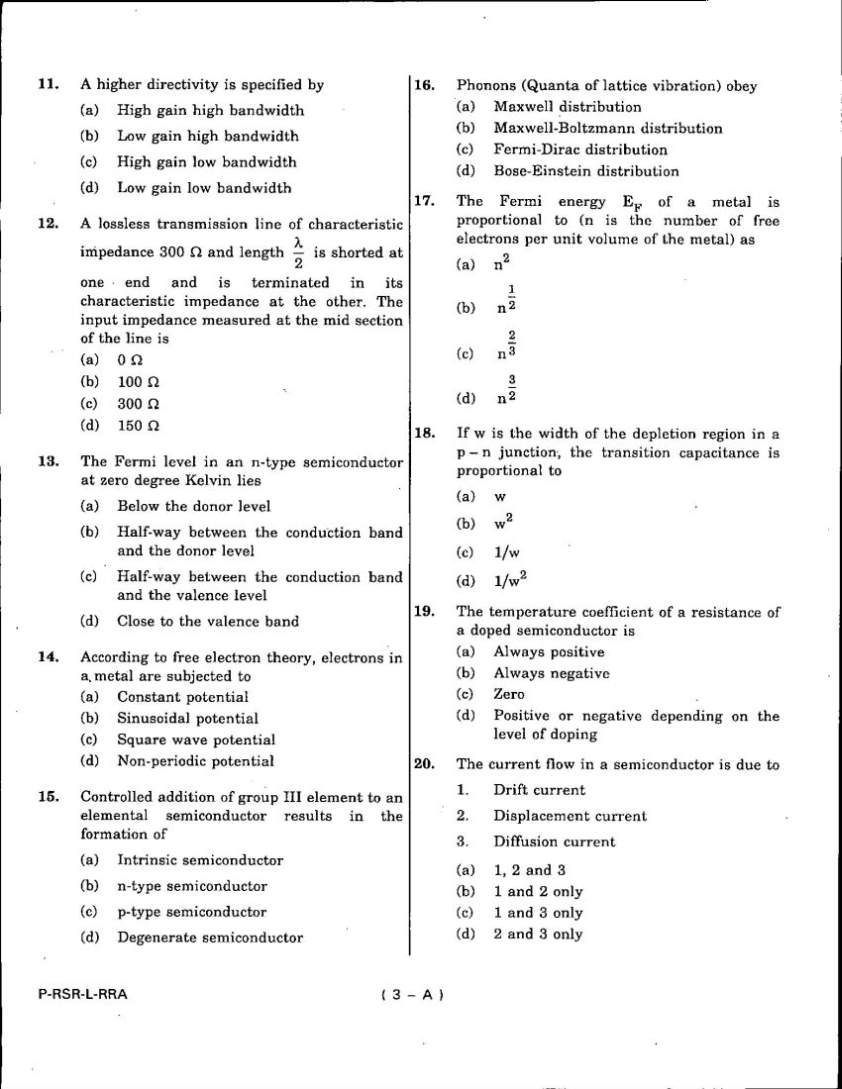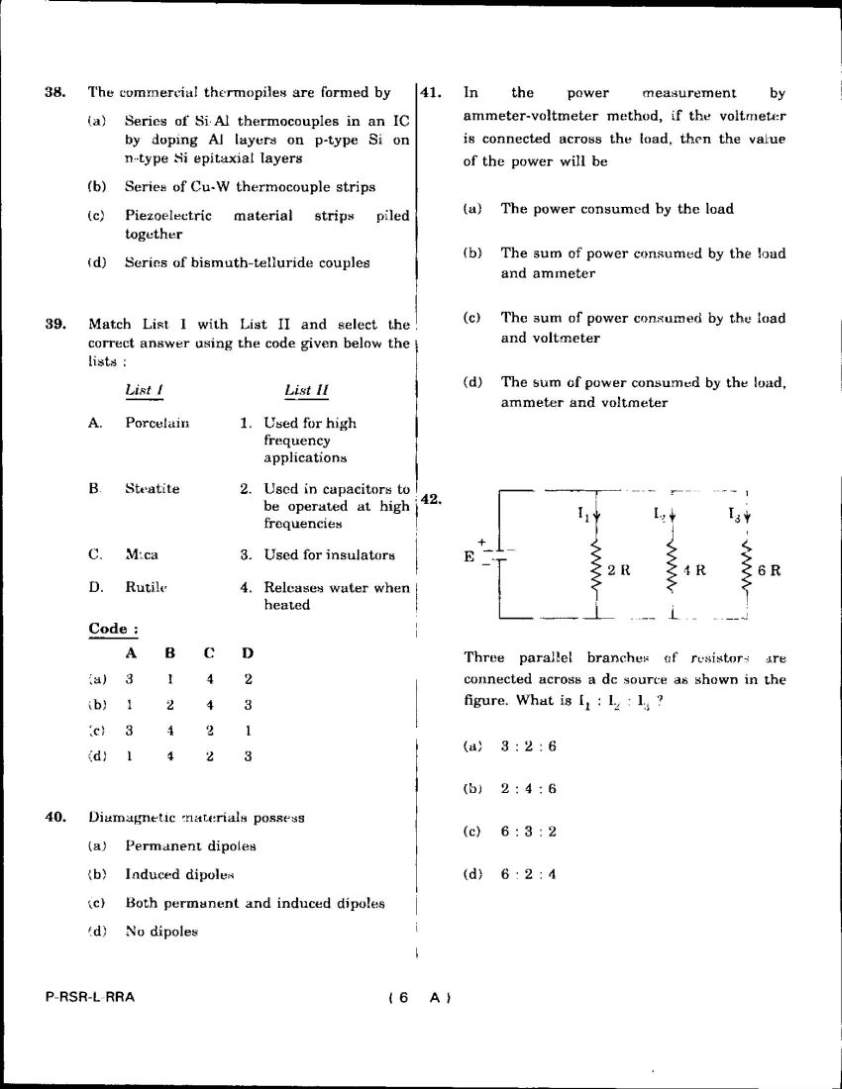Here I am providing the information regarding the IES Electrical Engineering Exam Question Paper for your idea .
Time Allowed: 2 hrs
Maximum Marks :200 marks
1. *-c'==-\----@15 -2£2 ""919
c \Nvx-
Z(S)""'"—> IFII g1!) 1F
For the driving point impedance function,-
2
Z(s) = ail—+7515, the circuit realization is
s +35+b
shown above. The values of ‘a’ and ‘b’
respectively are ‘
(a) 4 and 5
_ (b) 2 and 5
(c) 2 and 1
(d) 2 and 3
2. Consider the following statements :
The A to D converter used in a digital
instrument could be
1. Successive approximation converter
type.
‘ 2. Flash converter type.
3. Dual slope converter-type.
The correct sequence in the increasing order
of the conversion time taken by these types
is
(a) l, 2 and 3
(b) 2, 1 and 3
(c) l, 3 and 2
(d) 2, a and i
Q-GUG-K-FFA
4.
tzQAi
For photoconductors with equal electron and
hole mobilities and perfect ohmic contacts at
the ends, an increase in intensity of optical
illumination results in '
(a) a change in open circuit voltage
(b)? a change in short circuit current
(c) decrease in resistance
(d) increase in resistance
Consider the following statements in
connection with two-position controller :
1. If the controller has a 4% neutral zone,
‘ its positive error band will be 2% and
negative error band will be 8%.
2. The neutral zone is also known as dead
band.
3. The‘controller action of a two-position
controller is very similar to that of a
pure on-off controller.
4. Air-conditioning system works
essentially on a two-position control
basis. ‘
Which of the above statements are correct ?
(a) 1, 2 and 3 only
(b) 2, 3 and 4 only
(c) 2 and 4 only
(d) 1, 2, 3 and 4
For the following driving point impedance
functions, which of the following statements is
true ?
s+2‘
Z(s)=
1 52+35+5
s+2
Z(s)=
2 52+5
I 5+3
Z (s) = ———
3 $2+2s+1
Z405) _ (s+2)(s+4)
" (s+1)(s+3)
(a) Z1 is not positive real
(b) Z2 is positive real
- (c) Z3 is positive real
(d) Z4 is positive real 'Page 3
.6.
A piezoelectric crystal has a thickness of 9.
2-5 mm and a 'voltage sensitivity of
0-05 Vin/N. The piezoelectric crystal is I
subjected to an external _pressure_ of
1-6 x L06 N/m2, then the corresponding
output voltage is -
(a) 200 volts ‘
(b) .' 3-2 x 109 volts/m of thickness
(c) 0-07 X 10-9 V/(mS/New)
(d) 200 m volts.
'7.
2(5) ' 0'
——>
c—
A reactance' network ‘in the Foster’s I form
_ has poles at 0) = 0 (zero) and 0)

o
(infinity). The element in box-1 in the above
network is 10.
(a) a capacitor
(h) an inductor
(c) a parallel LC circuit
((1) a series LC circuit
8|. The measurement of Hall coefficient of -a
semiconductor with one type of charge-
carrier gives the information about
(a) sign of charge carrier
(b) density of charge carrier ‘
(c) - I both sign and density of charge carrier
((1) mass of the 'charge carrier
Q-GUG-K-FFA "[ 3 — A )
Consider the following statements with
reference to the phase plane :
1.7 They are general and applicable to a
system of any order.
2. Steady state accuracy and existence of
limit cycle can be predicted. 7 i
3. Amplitude and frequency of limit cycle if
exists can be evaluated.
4. Can be applied to discontinuous time
system. ‘
Which of the above statements are correct ?
(a) 1,2, 3 and 4 I
(b) ‘ 2 and 3 only
(c) 3 and 4 only
(d) 2, 3 and 4 only
Consider the following units 'for the
measurement of pressure directly : I
1. Rolta meter I
2. Bourdon tube
3. Planti meterl
4.. ‘ Varies J
Of these, the pressure can be measured by
(a) 1 and 2 only
(b) 3 and 4 only
(c) 2 only
(d) 1, 2, 3 and 4Page 4
11. 1 14.
‘ 1c 'wv» . O 2
Z11(s)i~—> 2L gRz *— Z22(S)
I ll: *0 2!
For the circuit shown above, the natural
frequencies at port 2 are given by s + 2 =‘ 0
and s + 5 = 0, without knowing which refers
to open-circuit and which to short-circuit.
Then the impedances Z11 and Z22 are given
respectively by
s + 5 s + 2
(a) K ,'
1 s + 2 K2 5 + 5
s + 2 s + 5
(b) K ,
1 s + 5 K2 5 + 2
s s + 2
c K —
( l 1 s + 5 K2 5 + 5
15.
s + 2 - s + 2
d K ,
( ) 1 s f 5 K2 s + 5
12. If reflection coefficient for voltage beIO-G, the
' voltage standing wave ratio (VSWR) is
(a). 0-66
(b) -4
(c) 1-5
(d) 2
13. Consider the following statements :
Piezoelectric materials serve as
1. 'A source of ultrasonic waves.
2. When electric field is applied, the
mechanical dimensions of the
substances are not at all altered.
3. Converts electrical energy to mechanical
and vice versa.
4. Converts thermal energy to electrical
energy. . '
Which of the above statements is/are correct '?
(a) 1 only
(b) 2 and 3 only
(c) 1 and only,
(d) - 1, 2, 3 and 4
Q-GUG-K-FFA l 4 - A l
A two-port network is defined by the
relation;
I1: 5Vl + 3V2
I2 = 2V1 — 7V2
The value of Z12 is
(a) 3
(b) - —3
3 _
(C) H
(d) 3
Consider the following statements :
1. The main shortcomings of diaphragms
are that they are prone to shock
vibrations.
2. Diaphragms have the advantages of high
accuracy and good dynamic response.
3. Selection of material for diaphragms
mainly depends upon temperature range
and chemical nature of fluid coming in
contact with diaphragm during pressure
measurement. I
Which of
correct ?
the above statements ‘ is/are
(a) 1, 2 and 3
(b) 2 and 3 only
(e) 1 only
(all 1 and 2 onlyPage 5
16. The Z-transform of X(K) is given by 18. Consider the following statements :
Z _ E1‘_.B_T)Z_1 Piezoelectric materials ‘
x( ) _ (I _ Z-1)(1 __e-TZ-1) 1.. . Crystal can be shown as electrical
equivalent circuit similar to an inductor
The initial value Km) is and a capacitor (Tank circuit).
2. Quartz, Rochelle salt, tourmaline.
a) zero '
( Used in voltage stabilizers.-
(b) 1 - 4. This exhibits the reverse effect of
electrostriction.
(c) 2
Which of the above statements are correct ?
(d) 3 I - (a) 1,2 and 4 only
I -(b) 1 and 2 onlyr
(c) 2 and 4 only
1 '(d) 1,2,3and4
17- L, ‘25 Q .
e W 0
+ + _ .
19. A balanced RYE-sequence, Y-connected (Star
7V1 1009; 211 - V2 connected) source with VRN = 100 volts‘is
connected to a A-connected (Delta connected)
_ _ balanced load of (8 + j6) ohms per phase.
0 '0
Then the phase current and line current
values respectively, are
The Y-parameters of the network shown
above are (a) 10 A; 30 A
(b) 10J§ A; 30 A
—0'04 004
(a) |: 1 (c) 10 A; 10 A
_-0-04 0-03
(d) 1.0J5A; 10J§A
(b) 004 _0'04 20. A resistance strain gage with gage factor
A ,_O-04 —003 (Sr) of 2 is bonded to a steel member, which
is subjected to a strain of 1 X 10—6. The
- _ original resistance value of this strain gage
F 0-04 —O-03 is 120 Q. The change in resistance due to
(c) . _. . -
__0_04 0.03 the applied strain 15
(a) 60 Q
_ (b) 240 >< 10-6 n _
—0-04 0-03
(d) 1 -(c) 2400 x
_ 0-04 0-037 (d) 60 x 10* o
Q-GUG-K-FFA I j 5 - A
A two-port network is described 'by the
21.
following equations : -
V1: 5011 +2012
V2 = 3011} 1012
Then, which one of the following is not
correct ? ‘
(a) Z12 = 20 ' '
(b) Y12 = 0-2
I (c) ‘ h12 = 2b
(a) A = 25
‘ 22. Match List I with last Il and select the correct
answer using the code given below the lists :
List I List I]
A. Hall effect- 1. Varistor
B._ Light energy . 2. Photodiodes
C. Electric field 3. Measuring low
magnetic field
D. Applied voltage 4. Liquid crystal
, display
Code :
A B C D
(a) 1 2 4 3
(b) 3 2 4 1 P
(c) \ 1 4 ' 2 3
‘ (d) 3 4 2 ' 1
23. The system matrix of a continuous time
system is given by A = [ O3 15]. Then the
characteristic equation is H
.(a) sz+5s+3l=0
(b) $2-ss-5=0
(c) s2+35+5=0
,(d) 52+s+2=0
For the question paper , here is the attachment
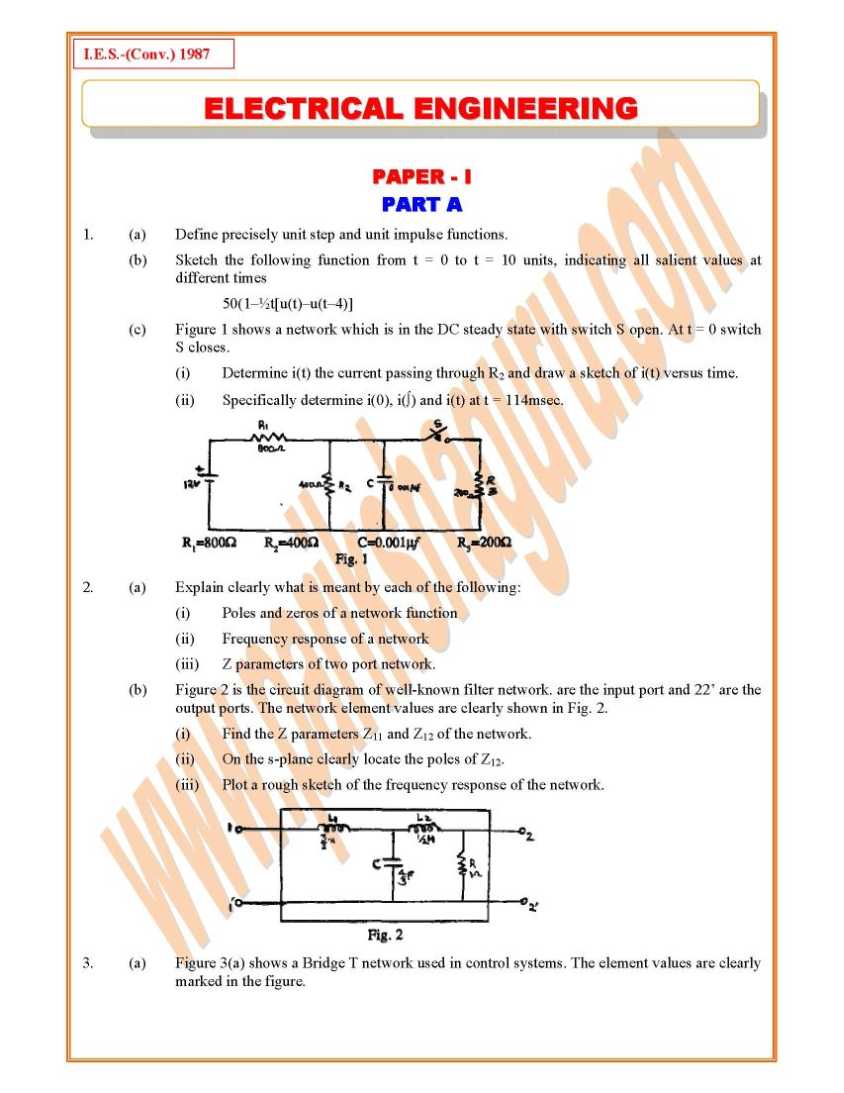

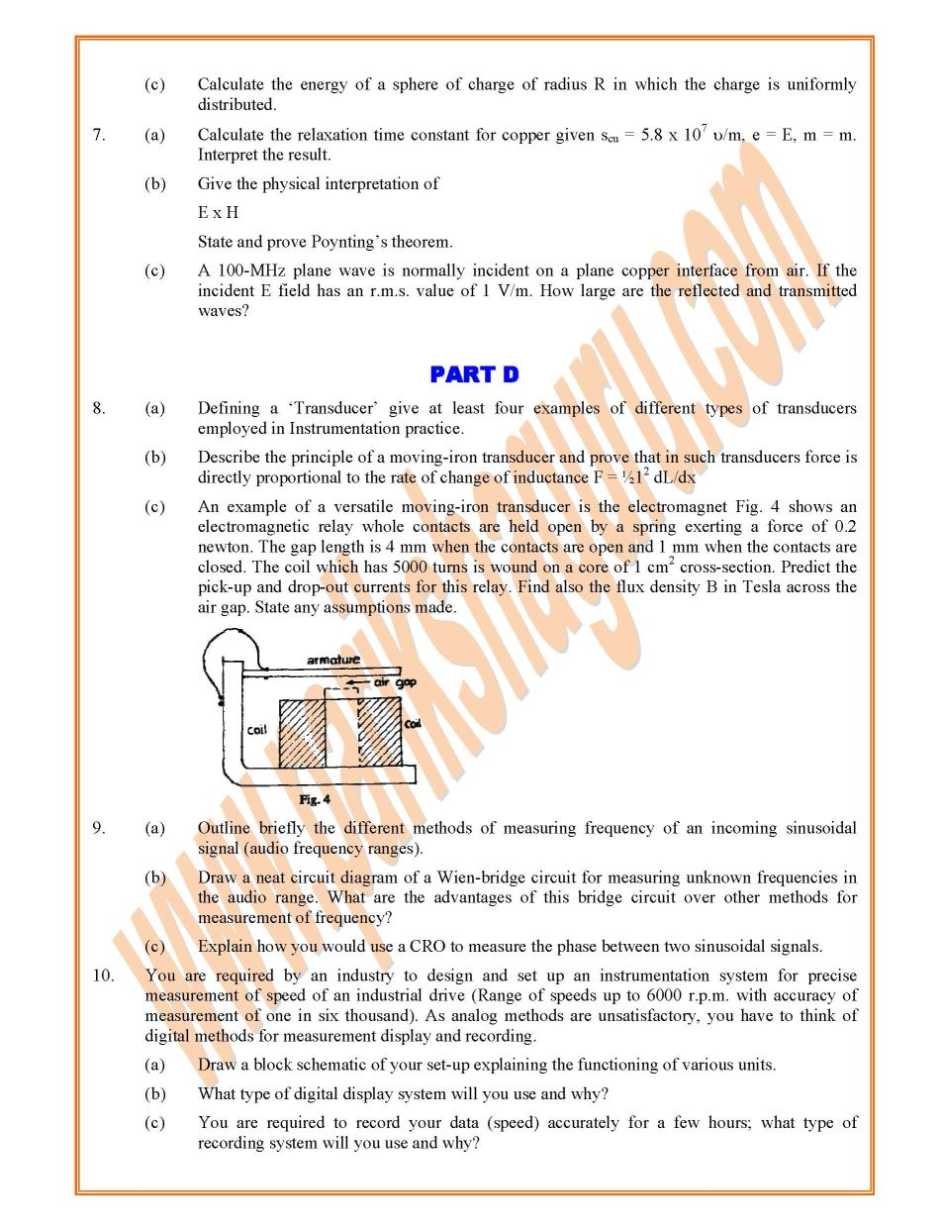
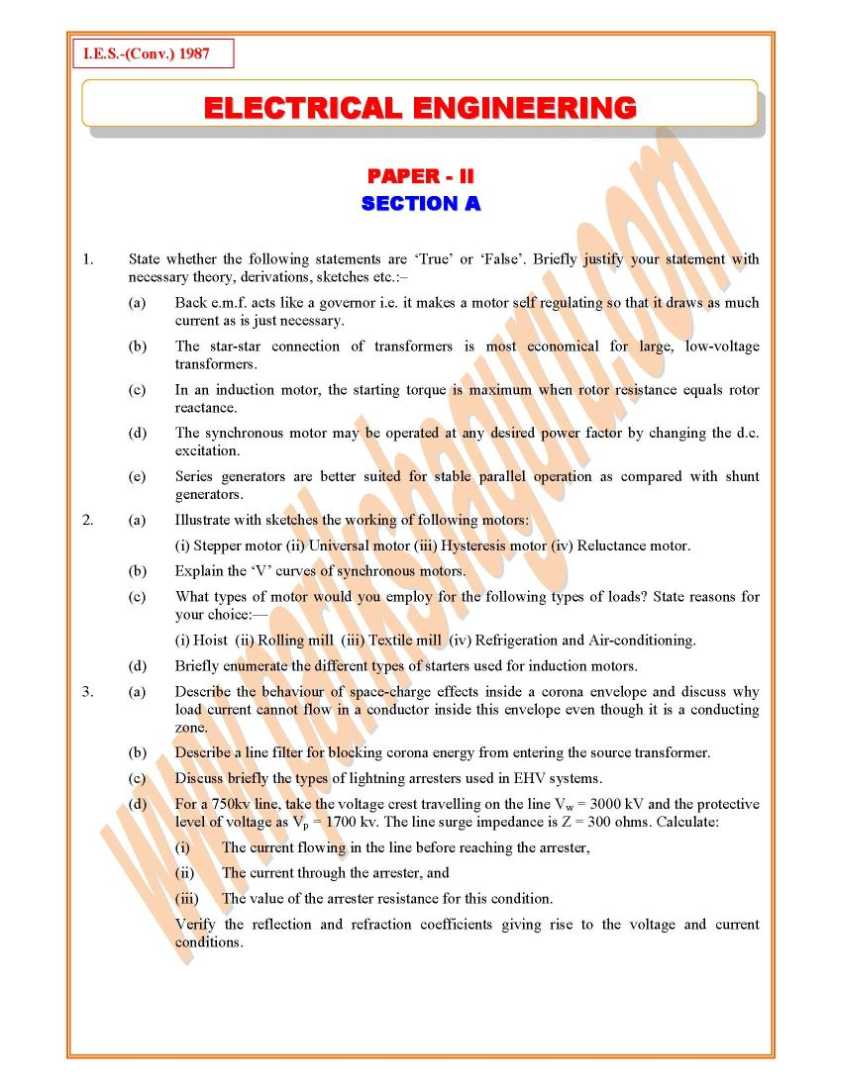
 o
o
